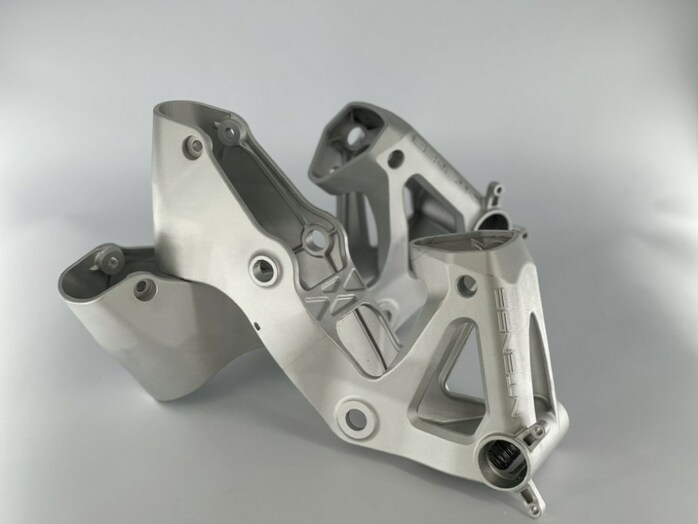Reimagining and improving the iconic INTENSE M1 downhill bike’s suspension required additive manufacturing to produce its new central “backbone” bottom bracket/suspension foundation
Elementum 3D, a leading developer and supplier of metal additive manufacturing (AM) advanced materials, print parameters, and services, is pleased to share that, working with TRUMPF Inc., its A6061-RAM2 alloy enabled a redesigned, additively manufactured “backbone” for INTENSE Cycles’ re-visioning of its legendary M1 downhill race bike. Competition between mountain bike manufacturers is just as extreme as among professional downhill riders racing to get down the course first. The bicycle industry is increasingly exploring the use of additive manufacturing (AM), or 3D metal printing, to prototype and print groundbreaking production parts.
INTENSE has been a bicycle industry and downhill bike leader for three decades, producing high-end carbon fiber and aluminum rides proven on the race circuit and coveted by riders at all levels of the sport. The company’s drive to keep improving its products and help its team compete in the most elite races has led to its adoption of additive manufacturing technology.
“I work and ‘think’ in aluminum, so AM opens a new world of creative opportunities for me and my team. We say INTENSE merges artistry and engineering, and I am no longer limited to metal sheets and tubes. I have the freedom to create almost any shape I want.”
INTENSE Founder and CEO Jeff Steber is a designer, artist, and craftsman with a hands-on approach. He’s enthusiastic about integrating AM into bike frame and part production. “I work and ‘think’ in aluminum, so AM opens a new world of creative opportunities for me and my team,” he said. “We say INTENSE merges artistry and engineering, and I am no longer limited to metal sheets and tubes. I have the freedom to create almost any shape I want.”
To reconceive the M1 downhill bike, a model that has edged other riders and their sponsors off the winners’ podium since the mid 1990s, Steber’s team planned to design and produce the M1’s backbone from one piece of 6061 Aluminum. The part and the material are critical to optimizing the bike’s suspension performance. The innovative new design incorporates internal ribbing to make it stronger and lighter; but this made it impossible to create using traditional machining techniques.
That naturally led the INTENSE production team to AM. They partnered with TRUMPF, which makes a broad range of manufacturing solutions, including 3D printers. The keys for INTENSE were TRUMPF’s experience printing bicycle parts and that it could print parts using weldable 6061 aluminum – Elementum 3D’s A6061-RAM2 – the same alloy INTENSE already used for its aluminum frames.
The first backbone designs were not ideal for printing, so TRUMPF advised INTENSE engineers on removing low-angle overhangs to improve printability. TRUMPF’s updated build processor, “TruTops Print,” increased downskin printability from 45° to 25° so the backbone printed with much less overhang-supporting material, reducing the chance for errors, material use, and post-processing effort.
TRUMPF contacted Elementum 3D for delivery of its A6061-RAM2 feedstock material. Delivery and finalizing technical details were completed faster than expected, allowing TRUMPF to immediately confirm the powder performed well with their existing infrastructure. It convinced INTENSE A6061-RAM2 was well-suited for in-house bike frame prototyping because it is easily welded and heat treated with other frame parts, including thin-wall tubing.
Christian Lengwenat, TRUMPF application engineer for metal 3D printing, was pleased with Elementum 3D’s involvement, stating, “Elementum 3D is professional and responds quickly. It’s comforting to work with a reliable, friendly group. Their advanced material properties and surface finish exceeded our expectations, and we plan to use more Elementum 3D powders in our machines.”
From the first test build, INTENSE appreciated A6061-RAM2’s weldability, finding it exactly like working with billet-machined 6061, with no porosity or contamination issues. TRUMPF liked the predictable processability, which enabled developing a working print parameter in two weeks and required printing just two DOEs (designs of experiments) to reach the material’s expected relative density value.
Both companies found A6061-RAM2 ideal for this project, particularly given the printed parts’ surface finish and accuracy. After the backbone was welded to the frame it was nearly impossible to determine which parts were printed, machined, or forged.
Steber remarked, “I’m thankful for the great work TRUMPF and Elementum 3D provided. Their guidance and expertise played a critical role in successfully producing our new M1. I am happy to report the M1 finished 2nd at the 2023 UCI Cycling World Championships.”
Based on this project and the bike’s performance, INTENSE is ramping up M1 production for consumers, and plans to incorporate AM into future prototyping projects and other production parts.
Subscribe to AM Chronicle Newsletter to stay connected: https://bit.ly/3fBZ1mP
Follow us on LinkedIn: https://bit.ly/3IjhrFq
Visit for more interesting content on additive manufacturing: https://amchronicle.com


